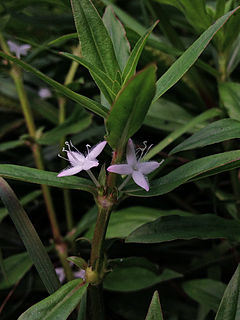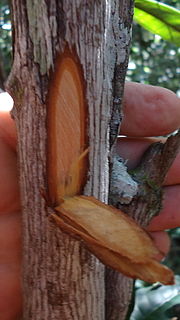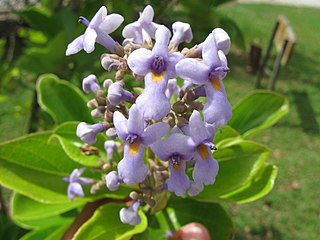
Diodia is a genus of flowering plants in the family Rubiaceae. It was described by Carl Linnaeus in 1753. The genus is found from southern and eastern United States, South America, Central America, Mexico, the West Indies and tropical Africa.

Lecythis is a genus of woody plant in the Lecythidaceae family first described as a genus in 1758. It is native to Central America and South America.

Alseis is a genus of flowering plants in the family Rubiaceae. It was described by Heinrich Wilhelm Schott in 1827. The genus is native to tropical Latin America from southern Mexico to Brazil.

Trichoceros is a genus of flowering plants from the orchid family, Orchidaceae. The genus is endemic to South America.
Chione is a monotypic genus of flowering plants in the family Rubiaceae containing the single species Chione venosa. It is native to the neotropics, occurring in most of Mexico, and throughout Central America, the Caribbean, Colombia, Ecuador, and Peru. It is typically a tree growing 10 to 20 meters tall. In harsh habitats, it may be dwarfed and shrubby. It has no known economic use.

Amaioua is a genus of flowering plants in the family Rubiaceae. It was first described by Jean Baptiste Aublet in 1775. The genus is native to tropical America from southern Mexico to Brazil, including Cuba and Trinidad.

Amphidasya is a genus of flowering plants in the family Rubiaceae. It was described by Paul Carpenter Standley in 1936. The genus is found in Central America and northern South America.
Appunia is a genus of flowering plants in the family Rubiaceae. It was described by Joseph Dalton Hooker in 1873. The genus is found from southern Mexico, Central America, and northern South America.

Arcytophyllum is a genus of flowering plants in the family Rubiaceae. The genus contains 18 species, distributed from New Mexico to Bolivia.

Chomelia is a genus of flowering plants in the family Rubiaceae. It is native to Mexico, Central America, the West Indies, and much of South America as far south as Argentina.
Cosmibuena is a genus of flowering plants in the family Rubiaceae. The genus is native to Chiapas, Central America, and South America as far south as Brazil.
Agouticarpa is a genus of flowering plants in the family Rubiaceae. It was described by Claes Persson in 2003. The genus is found from Costa Rica to Bolivia.

Calycophyllum is a genus of flowering plants in the family Rubiaceae. It was described by Augustin Pyramus de Candolle in 1830. The genus is found from Mexico, Central America, South America and the West Indies.
Capirona is a monotypic genus of flowering plants in the family Rubiaceae. The genus contains only one species, viz. Capirona decorticans, which is native to northern South America. It has been reported from French Guiana, Guyana, Suriname, Venezuela, Colombia, Ecuador, Perú, and northern Brazil.

Carapichea is a genus of flowering plants in the family Rubiaceae. It is native to Central America and northern South America from Nicaragua to Brazil. One species, Carapichea ipecacuanha, is used medicinally as the source of ipecac, a powerful emetic.

Ciliosemina is a genus of flowering plants in the family Rubiaceae. There are two recognized species distributed in South America from the eastern Andes to the Amazon basin.
Rosenbergiodendron is a genus of plants in the Rubiaceae. At present, it contains 4 recognized species, all native to tropical America.
Coccochondra is a genus of flowering plants in the family Rubiaceae. There are four species native to the Guayana Highlands of northern South America.

Cornutia is a genus of plants in the family Lamiaceae, first described in 1753. It is native to tropical parts of the Western Hemisphere: southern Mexico, Central America, West Indies, northern South America.
- Cornutia australisMoldenke - Ecuador, Brazil
- Cornutia coerulea(Jacq.) Moldenke - Jamaica
- Cornutia jamaicensisMoldenke - Jamaica
- Cornutia obovataUrb. - Puerto Rico
- Cornutia odorata(Poepp.) Schauer - Venezuela, Colombia, Ecuador, Peru
- Cornutia pubescensC.F.Gaertn. - French Guiana
- Cornutia pyramidataL. - southern Mexico, Central America, West Indies, Suriname, Venezuela, Colombia, Ecuador, Peru
- Cornutia thyrsoideaBanks ex Moldenke - Jamaica

Dr.Charlotte M. Taylor is a botanist and professor specialising in taxonomy and conservation. She works with the large plant family Rubiaceae, particularly found in the American tropics and in the tribes Palicoureeae and Psychotrieae. This plant family is an economically important group, as it includes plant species used to make coffee and quinine. Taylor also conducts work related to the floristics of Rubiaceae and morphological radiations of the group. Taylor has collected plant samples from many countries across the globe, including Chile, Colombia, Costa Rica, Panama, and the United States of America, and has named many new species known to science from these regions. As of 2015, Taylor has authored 278 land plant species' names, the seventh-highest number of such names authored by any female scientist.












